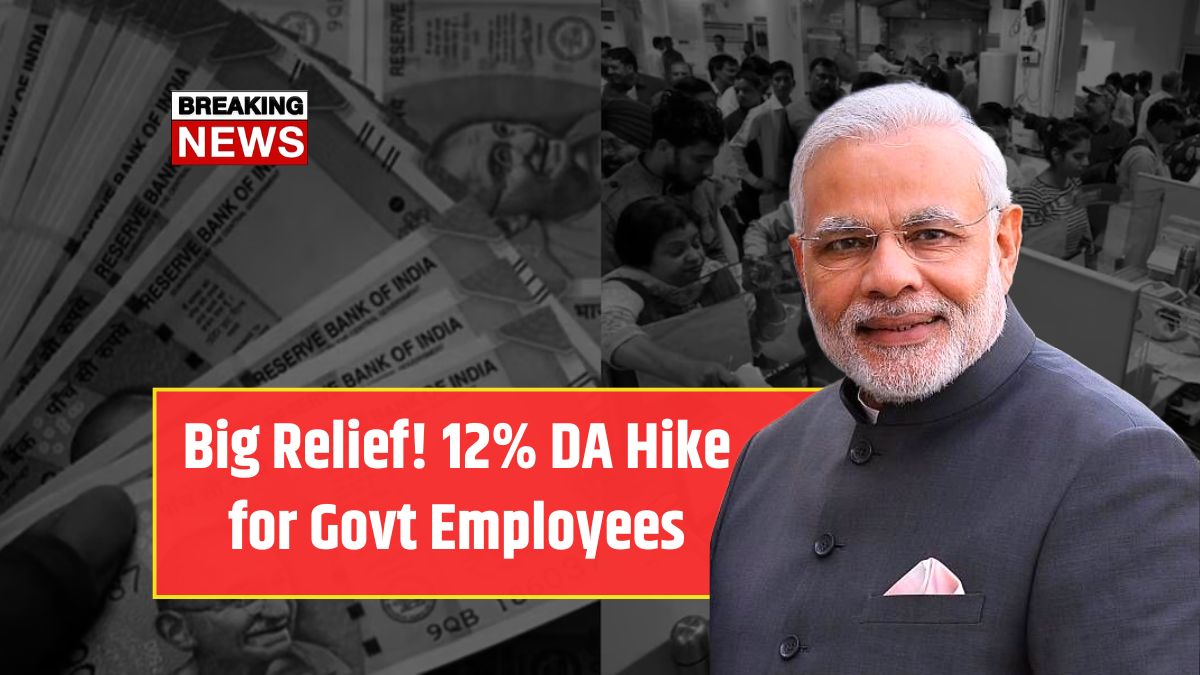DA Hike News – In a move that brings much-needed financial relief to millions of central government employees and pensioners, the government has approved a significant 12% increase in the Dearness Allowance (DA). This updated DA will be effective from July 1, bringing joy to many salaried workers as inflation continues to rise and living costs increase. The announcement follows the usual biannual revision of DA, which is based on changes in the Consumer Price Index (CPI).
What is Dearness Allowance (DA)?
For those who may not be familiar, Dearness Allowance is a cost of living adjustment that is provided to government employees and pensioners. This allowance is reviewed and updated twice a year—in January and July—to help offset the impact of inflation. Essentially, it helps ensure that employees can cope with the rising cost of living.
DA is calculated based on the All India Consumer Price Index (AICPI) and varies depending on whether the employee is working for the central government, state governments, or in public sector jobs. Importantly, DA is taxable and can vary based on the employee’s category.
Details of the 12% DA Increase
The recent announcement raises the DA from 50% to 62%, marking a 12% increase. This means a substantial rise in the income of government employees and pensioners. The new rates will apply from July 1, and the revised DA will be reflected in employees’ August salaries. However, the arrears for the month of July will be paid separately.
The increase in DA is part of the 7th Pay Commission framework, which ensures that employees receive regular adjustments to their salaries in line with inflation.
How Much More Will Employees Earn?
To give you an idea of how much more government employees will earn, let’s take a look at the estimated monthly increase based on different basic pay levels. The following table shows the difference in DA before and after the hike:
Also Read:
 Land Registry Rule: Land Registration for Just ₹1,000, New Rule from May 1 Will Blow Your Mind
Land Registry Rule: Land Registration for Just ₹1,000, New Rule from May 1 Will Blow Your Mind
- For an employee with a basic pay of ₹18,000, the DA will rise from ₹9,000 to ₹11,160, an increase of ₹2,160 per month.
- A person with a basic pay of ₹25,500 will see an increase of ₹3,060, taking their DA from ₹12,750 to ₹15,810.
- Employees earning ₹35,400 will receive an additional ₹4,248, with their DA increasing from ₹17,700 to ₹21,948.
- For those with a basic pay of ₹44,900, the increase in DA will be ₹5,388, raising the DA from ₹22,450 to ₹27,838.
- Employees with a basic pay of ₹56,100 will see an increase of ₹6,732 in their monthly earnings.
- Those with a basic pay of ₹67,700 will get an additional ₹8,124 every month.
- Employees earning ₹78,800 will see their DA increase by ₹9,456 per month.
- For the highest earners, with a basic pay of ₹1,00,000, the increase in DA will be ₹12,000 per month.
Annual Financial Impact
This DA hike will result in an increase in annual income for government employees as well. For example, an employee earning ₹18,000 per month will now earn an additional ₹25,920 per year. Similarly, those with a basic pay of ₹25,500 will see an annual increase of ₹36,720. This will provide much-needed financial relief for employees as they face increasing living expenses.
Who Will Benefit?
The 12% DA increase will benefit several categories of individuals:
- Central Government employees in all groups (A, B, and C)
- Central Government pensioners and family pensioners
- Railway employees
- Armed forces personnel
- Employees working in autonomous bodies receiving central government pay scales
This move will provide substantial support to those who have been facing financial strain due to inflation and rising costs.
What Does This Mean for the Economy?
On a broader scale, this DA hike will have an impact on the economy. As government employees and pensioners receive higher incomes, their purchasing power will increase, leading to more spending on consumer goods and services. This could provide a boost to the economy as demand for products rises.
Additionally, the DA revision is expected to influence state governments, as many may also revise DA for their employees in response to the central government’s hike. This chain reaction can provide financial relief to even more people across the country.
What About HRA?
Once DA crosses the 50% threshold, it often triggers a revision of House Rent Allowance (HRA) as well. While there has been no official announcement yet, it’s expected that the government will release a separate notification to address HRA revisions. This could further benefit government employees who live in rented accommodations.
In Line with the 7th Pay Commission
The 12% DA hike is in line with the 7th Central Pay Commission recommendations. According to these norms, DA is revised twice a year, taking into account the AICPI. This increase affects both current employees and pensioners. Other allowances linked to DA may also be adjusted as part of this revision.
The announcement of this 12% DA hike is a welcome move for government employees and pensioners who have been struggling with rising inflation. It brings much-needed financial relief and helps ensure that their income keeps pace with the increasing cost of living. Employees can expect the new DA to reflect in their August pay, with arrears for July being paid separately.
This move reaffirms the government’s commitment to the welfare of its employees and pensioners, ensuring that they continue to receive the support they need during these challenging times.




